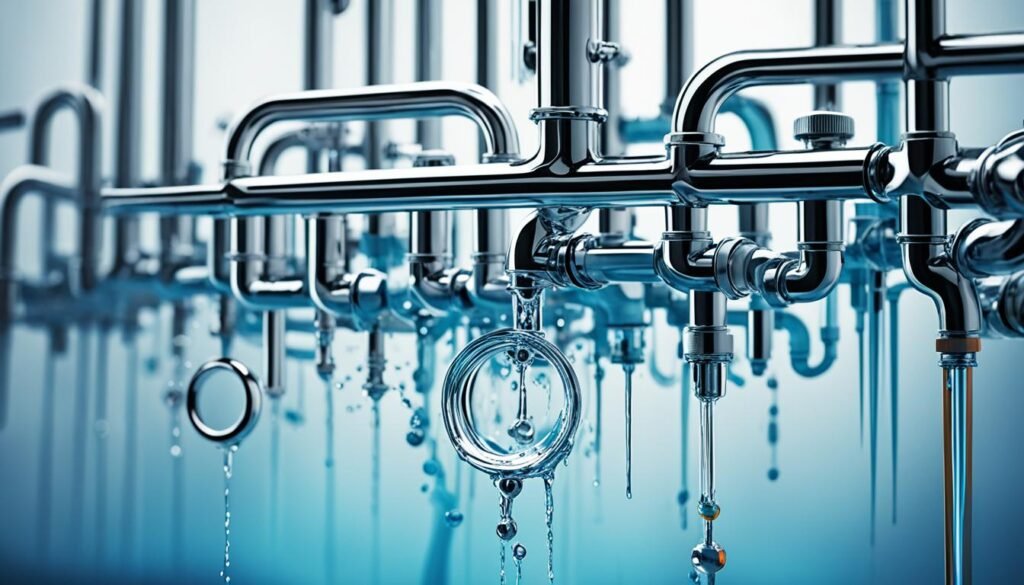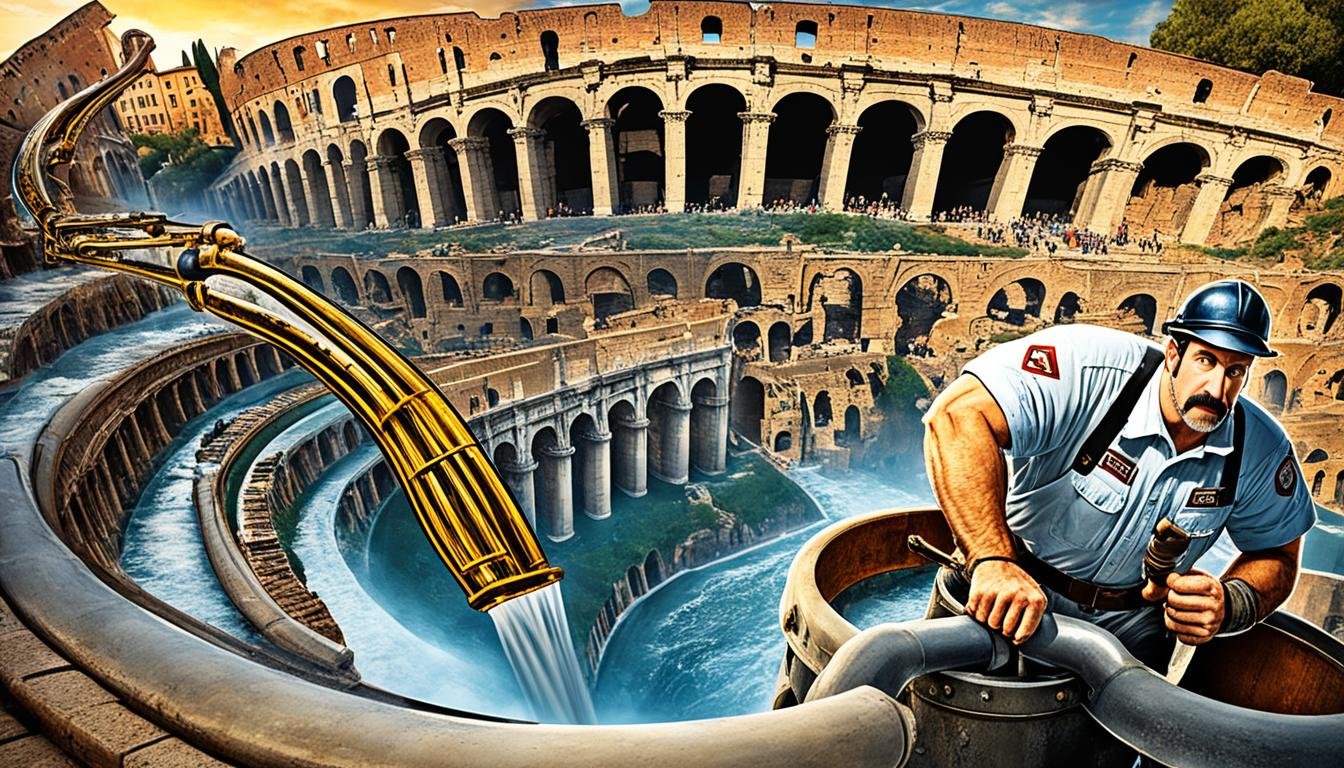Since 1963, U.S. homes have installed over 5.3 million miles of copper piping. That’s around 28 billion feet! This fact shows just how crucial plumbing is in our lives. The history of plumbing is rich, from ancient times to today’s tech-savvy systems.
The story of plumbing is full of interesting tales and surprising details. We’ll dive into the past, learn some new facts, and see the amazing progress in plumbing. Let’s explore the world of pipes and water together.
Key Takeaways
- Plumbing has a rich history dating back to ancient Greece and the invention of the flush toilet.
- Plumbing innovations have significantly impacted water usage and conservation, with low-flush toilets saving up to 18,000 gallons of water per year.
- Surprising plumbing facts, such as the average American spending 240 days on the toilet and the high number of bacteria in dishcloths compared to toilets.
- Interesting plumbing trivia, like the $19 million toilet on the International Space Station and the preference for toilet paper flap placement.
- Plumbing advancements have played a vital role in the development of major American cities, such as Chicago and Philadelphia.
A Glimpse into the Origins of Plumbing
Plumbing brings clean water into homes and removes waste. Its history is fascinating, dating back thousands of years. From Greece and Egypt’s early days to our modern systems, plumbing has changed a lot.
Ancient Innovations
Ancient Greece leads us to the first forms of plumbing. The Minoans, on Crete, had a flush toilet around 1700 B.C. This was a big step forward. Meanwhile, Egypt was using copper pipes, showing their skill in engineering.
The word “plumber” comes from the Latin word “plumbum,” which means lead. At that time, lead pipes were common. This shows how long plumbing has been around as a profession.
Early Advancements
Civilizations kept making their plumbing better as they advanced. In the 1700s, before toilet paper, people used corncobs. This was their creative solution. Archaeologists have found early plumbing examples. These show the progress that leads to today’s plumbing.

Learning about plumbing’s past is interesting. It shows the cleverness of our past generations. From the first toilets to using copper and lead, the origin story is remarkable.
Interesting Plumbing Facts
Plumbing has played a key role in life since ancient times. It’s always changing, with new designs and cool facts. There’s so much to know about plumbing, from its terms’ history to water use trivia.
The toilet got its nickname “the john” because of Sir John Harrington. He made the first flush toilet in 1596. “The crapper” comes from Thomas Crapper, a London businessman. It’s neat to see how plumbing connects to surprising people too, like musician Ozzy Osbourne, who started as a plumber.
You might not realize how much water simple plumbing issues can waste. A running toilet can use up to 5 gallons a minute. A dripping faucet wastes over 3,000 gallons a year. Each American family of four uses about 400 gallons daily. And flushing the toilet is the single largest water use in most homes.
Switching to a low-flush toilet could save 18,000 gallons yearly. About 95% of the water in our homes doesn’t get reused. Often, more than 9,000 gallons of water are wasted while waiting for the shower to get hot.
The history and facts of plumbing are fascinating. They shine a light on how we use and often waste water. Whether you’re a homeowner, a plumber, or just curious, these plumbing facts are interesting and informative.

“Plumbing is not just about pipes and faucets; it’s about the science, history, and innovation that keep our homes and communities running.”
Plumbing Innovations and Trivia
The plumbing world has seen big changes over the years. It started with cast iron pipes in Philadelphia back in 1804. Now, we have cool things like Japanese toilets that flush when you talk to them. Plumbing tech has come a long way and keeps surprising us.
Innovative Designs
Low-flush toilets are a huge deal for saving water. They use way less water, up to 18,000 gallons less each year. The Tremont Hotel in Boston then did something amazing in 1829. It was the first to have indoor plumbing, leading to the bathrooms we have today.
The toilet on the International Space Station cost an incredible $19 million. It’s built to work without gravity, showing just how smart plumbers are. They can solve any problem, even in space.
Curious Facts
- During the Super Bowl halftime, the most toilets are flushed all year. It’s when a huge number of people use the bathroom at the same time.
- Sir John Harrington is the man behind the first flushing toilet in 1596. This is why toilets are sometimes called “the John.”
- Before 1857, there wasn’t packaged toilet paper. Then, Joseph Gayetty made the first. This changed how people clean up after going to the bathroom.
These fun facts and cool designs show how important plumbing is in our lives. It’s been around for thousands of years and is always getting better. Plumbing is about people being smart and always looking for new ideas.
In plumbing, there’s always something new to learn or see. Whether it’s fancy toilets from Japan or toilets in space, the world of plumbing is full of surprises. Learning about these things helps us understand how plumbing has shaped our world.
Conclusion
Plumbing has been important for a long time, showcasing a rich history and constant change. It started in ancient Greece and has grown into today’s water-saving and high-tech advancements. This industry is filled with interesting facts that can change our view of everyday life.
This article gives a detailed look at plumbing, from the ancient past to now. It makes you see the importance of plumbing in our daily lives. Talking about things like PVC pipes’ durability and key inventions like the flush toilet, plumbing has always met society’s needs.
Exploring plumbing’s past and present shows it stays vital for us. We’re aiming for a future where plumbing is eco-friendly and cost-effective. Let’s recognize the hard work of those in the plumbing industry. They help keep our lives comfortable and convenient.
FAQ
What are the origins of plumbing?
Plumbing began in ancient Greece. The first plumbers there created a system for sewage and drains. They also made the first flush toilet in Crete, around 1700 B.C. Egyptians of olden times used copper pipes in their plumbing too.
Where does the word "plumber" come from?
The term “plumber” comes from the Latin “plumbum,” which means lead. Lead was often used in making water pipes in the past.
What were alternatives to toilet paper in the past?
Back in the 1700s, people used corncobs before toilet paper was invented.
What is the origin of the nickname "the john" for the toilet?
The name “the john” comes from Sir John Harrington. He designed the first modern flush toilet in 1596.
Where does the term "the crapper" come from?
“The crapper” comes from a man named Thomas Crapper. He started a sanitation business in London.
Did any unexpected figures have a career in plumbing?
Surprisingly, Ozzy Osbourne, the musician, was a plumbing apprentice before he became famous.
What was the first city to use cast iron pipes in plumbing?
Philadephia was the pioneer. It used cast iron pipes first in 1804 for its plumbing system.
What was the first hotel to offer indoor plumbing?
The Tremont Hotel in Boston achieved this milestone in 1829. It was the first to provide indoor plumbing.
What are some recent innovations in plumbing?
Some new plumbing inventions are low-flush toilets and Japanese urinals. The urinals have a flush that you can operate by voice. Low-flush toilets can spare about 18,000 gallons of water a year.
What is the most expensive toilet in the world?
The International Space Station boasts the most costly toilet, a million model.
When does the highest number of flushed toilets occur?
During the Super Bowl halftime show, we see the most toilets getting flushed.
Source Links
- https://davishomeservices.com/expert-tips/plumbing-facts/
- https://www.benjaminfranklinplumbing.com/expert-tips/general-plumbing/20-fun-facts-about-plumbing/
- https://onesourcehomeservice.com/blog/fun-plumbing-facts/
- https://www.robinsonplumbing.com/fun-facts-about-plumbing
- https://www.bdplumbers.com/press-releases/fun-white-house-plumbing-facts/
- https://www.pmengineer.com/articles/83992-greatest-plumbing-heating-inventions-1900-1950
- https://www.trident-plumbing.com/news-resources/fun-but-costly-plumbing-facts-2022-02-4094
- https://goldsealplumbing.com/blog/fun-facts-about-plumbers-and-plumbing
- https://www.plumbingdynamicsdallas.com/15-interesting-plumbing-facts-and-tips/
- https://plumbermurrieta.plumbing/blog/fascinating-plumbing-facts-to-know/
- https://www.beniciaplumbing.com/blog/2019/september/fun-and-funky-plumbing-trivia/
- https://www.plumbingsolutionsllc.com/uncategorized/interesting-facts-about-plumbing/
- https://facts.net/plumbing-facts/
- https://www.brotherplumber.com/post/interesting-plumbing-facts
- https://www.robinsonplumbing.com/plumber-facts

